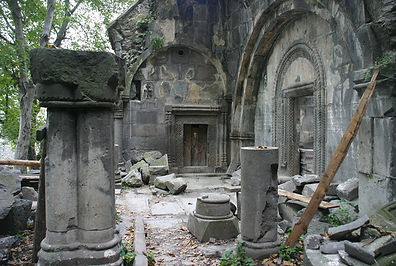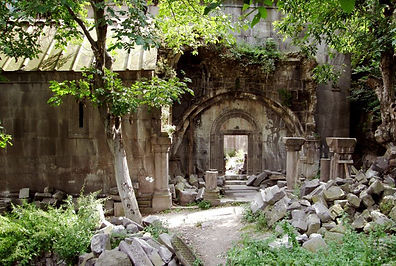Aparan-The Monument to “Armenian alphabet”-Haghpat-Sanahin-Odzun-Kobayr

The monument to “Armenian alphabet” is located in Oshakan, at the east side bottom of Mt. Aragatz. The monument is erected by the design of the famous Armenian architect J. Torosyan (1962). It is an interesting demonstration of the stone carvings of 39 Armenian letters.
Armenians appreciate their ancient history, their ancient places of worship and their ancient monuments. The name Sanahin means "This is older then the other one". Historians believe that the name of this beautiful village has come forth when its villagers boasted of having a church that was older then that in Haghpat, the notorious Haghpat monastery. People have lived in this village for hundreds of years. This village that seems a very regular one to a visitor, in fact was a leading center for religious, cultural and theological studies throughout Middle Ages. Once in this village one should certainly visit the Sanahin monastery and the Migoyan Brothers' Museum. People in this village are very hospitable and are willing to share their stories, so if you speak Armenian and Russian, you should talk to them and learn more about old stories.

The design and scientific significance of the Sanahin Monastery's architectural construction is beyond national. The unity and compactness of the whole monastery complex were achieved due to the fact that for a period of three centuries all the architects thoroughly examined everything built by their predecessors and built on their past experience. The Sanahin Monastery is situated on a small plateau at Debed river canyon, 1000 meters above sea level. The exact time of its establishment is not known; however, historians' evidences prove its existence long before the X century, while in the X-XI cc the number of monks had already reached several hundreds. Like in Haghpat, medieval calligraphers studied theology and humanities here, translated Euclid's and Plato's works bringing together antique and oriental traditions typical to the Silver Era.


The establishment of the Haghpat Monastery situated to the north-east of Sanahin dates back to the X century. The local monks in the Haghpat Monastery devoted themselves to the Word of God. They studied theology, humanities and fine arts. During the XI-XII cc the monks tried to turn the monastery into a repository of everything written in Armenian thus making it the first Matendaran. In search of manuscripts the monks wandered the mountains, dug in the book-depositories under the dusty vaults of monasteries from Van to Urmia and copied everything that was impossible to move. And during the hard times when they heard rumors about the invasions of Turan or Mongol hordes they gathered their works, ran away to the mountains and hid the thin parchment papers in the caves. There are evident similarities between the characteristic features of the Haghpat and Sanahin monasteries. The architectural details and the decors of both monasteries belonging to the same era have a lot in common and allow us to suppose their performance by the masters of the same school. At the end of the 18th century prominent ashugh (folk singer-songwriter) Sayat-Nova lived in this monastery.
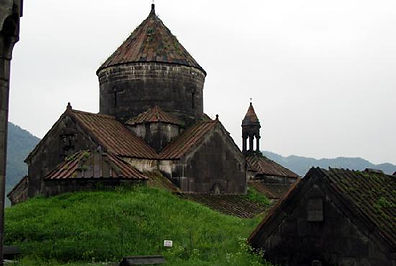
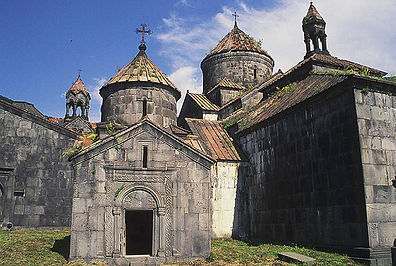
"The church is situated in the north of Armenia in the village of Odzun in the region of Alaverdi. In its original conception, variety and majesty of surfaces and volumes, it is considered one of the finest Armenian cupola type basilicas. On the north and south side, it has arcaded cloisters while the west cloister has a blind wall with an arched entrance in the middle. To judge by its architectural and artistic properties the edifice belongs to the sixth or seventh centuries. In the time of Hovanes Otznetsi (8th century) some complementary work was probably executed in various parts of the building."
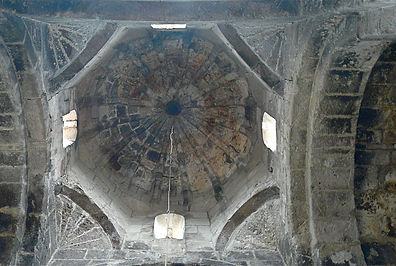
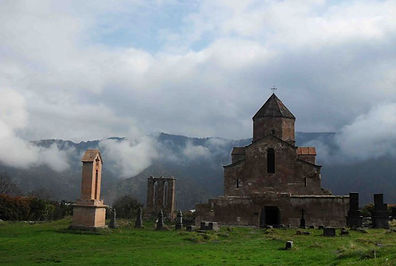
Qobayr monastery is an ancient sanctuary located on top of a canyon. Here the water flows as if from under the rocks and the trees and grapevines grow from apertures of the ancient carved walls. A bell tower is preserved in the middle of the complex which was built as a crypt for Mkhargreli and his wife Vaneni.
